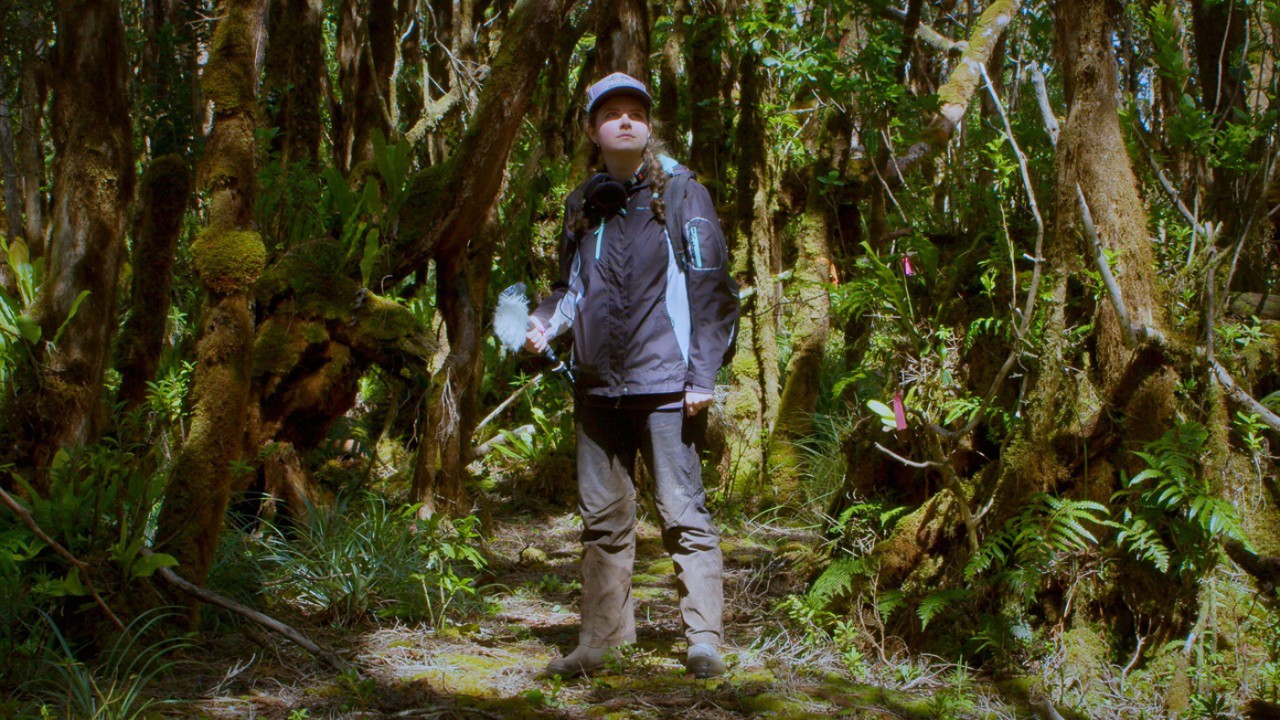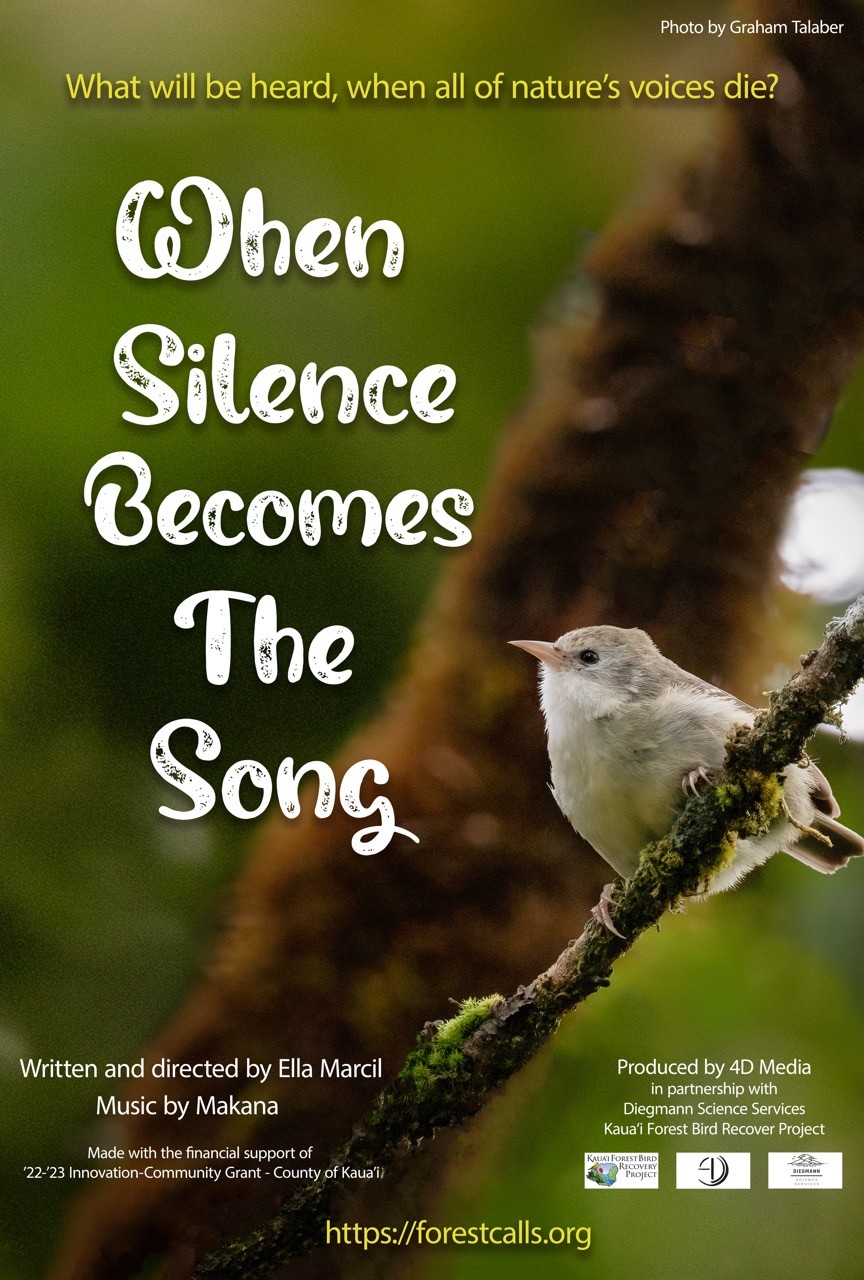
UC student documents wildlife tragedy in Hawaii
Digital media major follows researchers’ desperate bid to save a songbird
Filmmaker Ella Marcil spent two weeks this summer documenting the tragic end of an endangered species in her home state of Hawaii.
Marcil, a digital media student at the University of Cincinnati, was commissioned by Kauai County’s Office of Economic Development to document the work of scientists who are scrambling to save the last members of a songbird called the akikiki.

The akikiki, a species of honeycreeper, is believed to be extinct in the wild. Researchers are pinning their hopes on a captive breeding program. Photo/Graham Talaber
Marcil accompanied the Kauai Forest Bird Recovery Project as it scoured the top of the high-altitude Halehaha plateau more than 4,000 feet above sea level looking for the bird, a species of honeycreeper.
The little gray-and-white bird used to be a common backyard visitor across the island, Marcil said. But the introduction of avian malaria to the island began to devastate akikiki populations. Birds that lived at higher, colder elevations were safe for a while. But a warming climate on the island allowed mosquitoes to reach higher into the mountains where the malarial parasite has killed virtually every surviving bird.
Growing up in Hawaii, Marcil said the akikiki often went unnoticed because of its drab colors and small size, flitting about the treetops and calling in a high-pitched peep.
“What’s really devastating is the akikiki once was as common as a pigeon on Kauai,” Marcil said.

Ella Marcil holds up a sweatshirt promoting the efforts of researchers to save endangered species in Hawaii. Photo/Andrew Higley/UC Marketing + Brand
Her last film was about the Hawaiian community of Haena’s efforts to reestablish the sustainable farming, fishing and conservation practices of their ancestors.
For this current project, she trekked up the rugged and treacherous mountain pass with researchers to reach the forested plateau where they would spend nearly two weeks searching for any surviving birds, hatchlings or eggs.
The plateau isn’t just rugged — it can be wet and freezing, too.
“Kauai is called the ‘Garden Island’ for a reason — all the rainfall we receive,” she said.
“Ordinarily, Hawaii is a warm place of sun. But hikers who come here unprepared can die from hypothermia,” she said. “The conditions are extreme.”

The movie poster for Ella Marcil's new documentary features the unassuming akikiki. Photo/Provided
Exactly how avian malaria arrived in Hawaii is a mystery. People could have introduced it through domestic fowl. Or far-flying seabirds might have introduced it to the island.
But once there, it quickly began decimating birds that had no natural defenses.
Marcil followed researchers as they searched the forest and tried to get any birds to respond to audio playbacks of their calls. But wherever they went, no birds called back.
“You could hear the wind and nothing else. It was disheartening,” she said.
Researchers were hopeful they could collect birds from the last known nest.
But the day they were to depart for the plateau, a storm struck the island. When researchers got there, the nest was abandoned and the hatchlings had died.
“It’s devastating,” Marcil said. “You see thousands of years of evolution dwindle to nothing just like that.”
Humans caused this problem. So now it’s up to people to fix it.
Ella Marcil, UC digital media student
Now researchers are dedicating their attention to a captive-breeding program for the world’s last akikiki on the neighboring island of Maui. And they are still working to prevent other endangered birds on the islands from facing a similar fate from avian malaria.
“We have about three species that are just as critical at this point,” David Smith, administrator for the Hawaii’s Division of Forestry and Wildlife, said in a statement. “They’re right on the verge of extinction. Literally, some of these species could go extinct within months. They’re just falling out of the sky.”
Hawaii is turning to a biological control in which biologists release huge numbers of male mosquitoes infected with a natural but incompatible bacteria that renders wild female mosquitoes sterile.
Unlike most places in the world, mosquitoes are not native to Hawaii — they were introduced by people — so eliminating them altogether from the food chain will not have harmful ecological consequences.
“Humans caused this problem,” Marcil said. “So now it’s up to people to fix it.”

UC College of Arts and Sciences student Ella Marcil trekked up a high-altitude plateau to document the work of researchers trying to save a songbird from extinction. Photo/Provided
Climate change is having a disastrous impact on people and wildlife around the world. Hawaii in August saw the nation’s deadliest wildfire of the past century on the western side of Maui. The fire killed 97 people, devastating neighborhoods across western Maui. The fire spared the akikiki rehabilitation center.
“We were showing a community screening for the doc the day the Maui fires were happening,” Marcil recalled.
Once the documentary is complete, she hopes to enter it into film festivals. And she would like to show it in Cincinnati and on campus.
“I’m proud of this documentary and the way it immortalizes this bird through the lens of the camera,” she said.
Marcil said while the story of the akikiki is unique to Hawaii, the problem of wildlife extinction is a global issue affecting every corner of the planet.
“It’s a unique story to Hawaii, but it’s a rallying call to protect a species. It shows that people do care,” she said. “It’s devastating to see, but you can’t give up hope. You have to keep trying.”
Featured image at top: UC College of Arts and Sciences student Ella Marcil stands in the atrium of Clifton Court Hall. Her new film will explore the plight of a bird endemic to Hawaii. Photo/Andrew Higley/UC Marketing + Brand

UC College of Arts and Sciences student Ella Marcil makes films about people who are making a difference in the world. Photo/Andrew Higley/UC Marketing + Brand
Become a Bearcat
Whether you’re a first-generation student or from a family of Bearcats, UC is proud to support you at every step along your journey. We want to make sure you succeed — and feel right at home.
Related Stories
UC student documents wildlife tragedy in Hawaii
October 11, 2023
Ella Marcil, a digital media student at the University of Cincinnati, was commissioned by the Kauai County Office of Economic Development to document the work of scientists who are scrambling to save the last members of a songbird called the akikiki.
UC honors students to lawmakers: Here are ideas to fix public education
December 2, 2020
On Dec. 7, University of Cincinnati honors students in the Save our Schools! seminar will present Ohio political leaders with their best ideas to address some of the state’s thorniest education issues at an educational reform symposium, to be held via remote technology.
Study tests whether election truths can combat lies
October 28, 2020
Election lies are difficult to overcome say cyber security researchers who simulated an attack on the 2020 presidential election.
